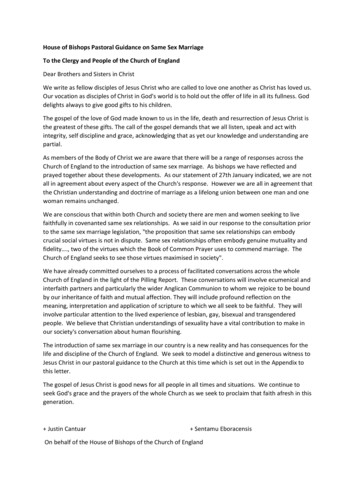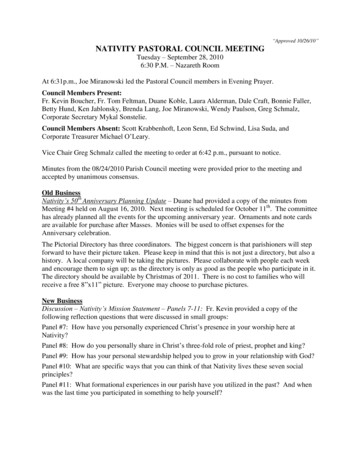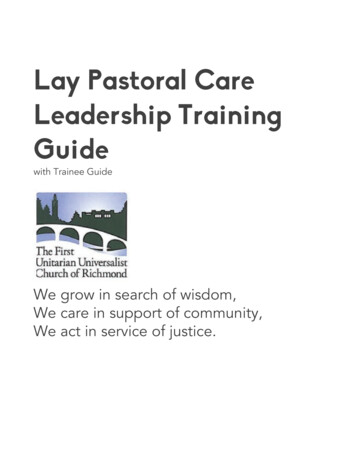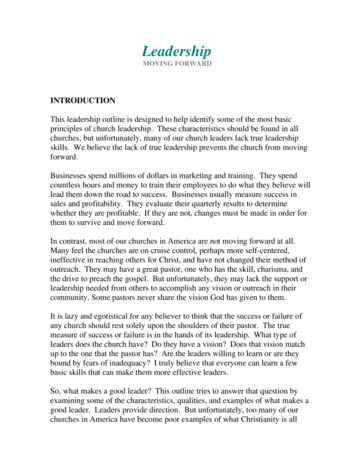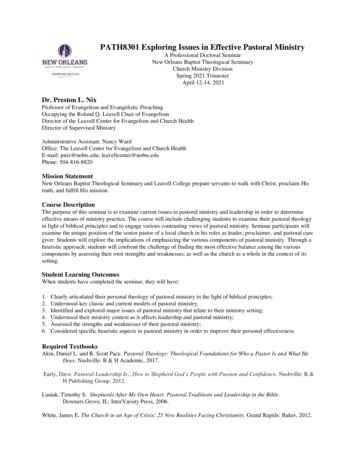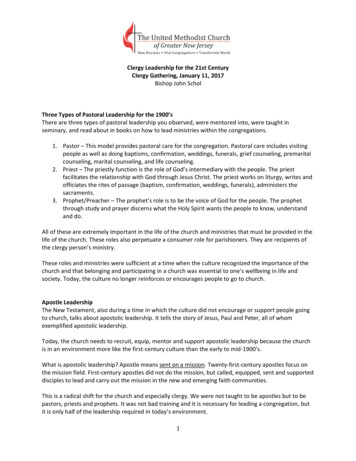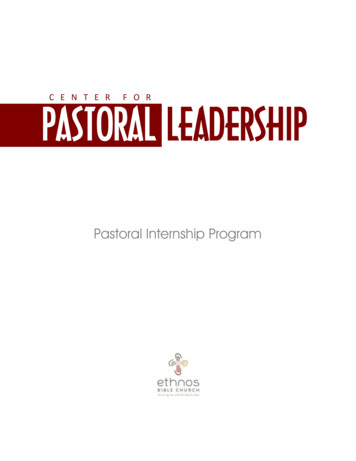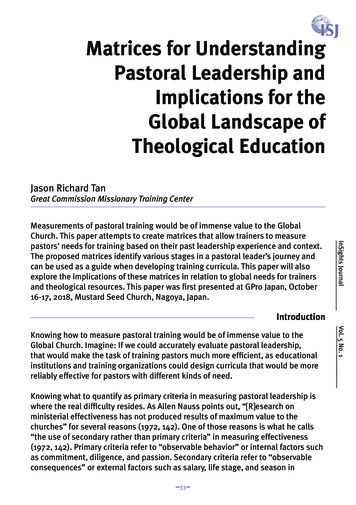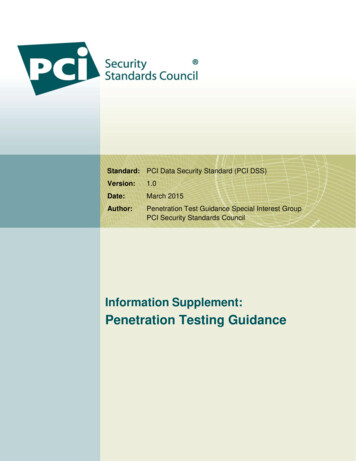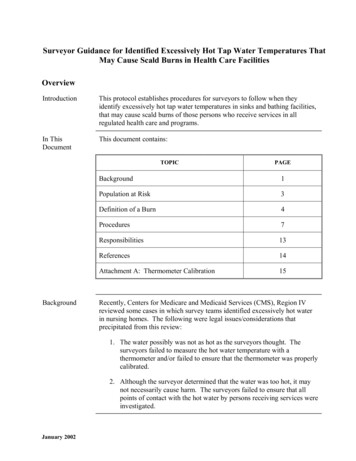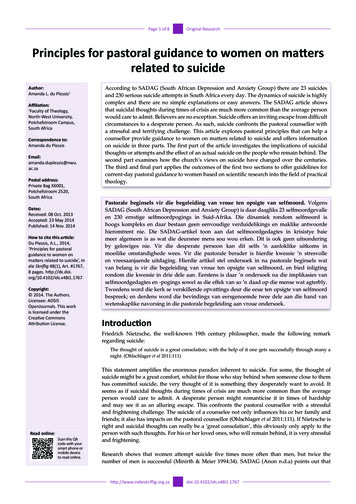
Transcription
Page 1 of 8Original ResearchPrinciples for pastoral guidance to women on mattersrelated to suicideAuthor:Amanda L. du Plessis1Affiliation:1Faculty of Theology,North-West University,Potchefstroom Campus,South AfricaCorrespondence to:Amanda du PlessisEmail:amanda.duplessis@nwu.ac.zaPostal address:Private Bag X6001,Potchefstroom 2520,South AfricaDates:Received: 08 Oct. 2013Accepted: 23 May 2014Published: 14 Nov. 2014How to cite this article:Du Plessis, A.L., 2014,‘Principles for pastoralguidance to women onmatters related to suicide’, Indie Skriflig 48(1), Art. #1767,8 pages. http://dx.doi.org/10.4102/ids.v48i1.1767Copyright: 2014. The Authors.Licensee: AOSISOpenJournals. This workis licensed under theCreative CommonsAttribution License.According to SADAG (South African Depression and Anxiety Group) there are 23 suicidesand 230 serious suicide attempts in South Africa every day. The dynamics of suicide is highlycomplex and there are no simple explanations or easy answers. The SADAG article showsthat suicidal thoughts during times of crisis are much more common than the average personwould care to admit. Believers are no exception. Suicide offers an inviting escape from difficultcircumstances to a desperate person. As such, suicide confronts the pastoral counsellor witha stressful and terrifying challenge. This article explores pastoral principles that can help acounsellor provide guidance to women on matters related to suicide and offers informationon suicide in three parts. The first part of the article investigates the implications of suicidalthoughts or attempts and the effect of an actual suicide on the people who remain behind. Thesecond part examines how the church’s views on suicide have changed over the centuries.The third and final part applies the outcomes of the first two sections to offer guidelines forcurrent-day pastoral guidance to women based on scientific research into the field of practicaltheology.Pastorale beginsels vir die begeleiding van vroue ten opsigte van selfmoord. VolgensSADAG (South African Depression and Anxiety Group) is daar daagliks 23 selfmoordgevalleen 230 ernstige selfmoordpogings in Suid-Afrika. Die dinamiek rondom selfmoord ishoogs kompleks en daar bestaan geen eenvoudige verduidelikings en maklike antwoordehieromtrent nie. Die SADAG-artikel toon aan dat selfmoordgedagtes in krisistye baiemeer algemeen is as wat die deursnee mens sou wou erken. Dit is ook geen uitsonderingby gelowiges nie. Vir die desperate persoon kan dit selfs ’n aanloklike uitkoms inmoeilike omstandighede wees. Vir die pastorale berader is hierdie kwessie ’n stresvolleen vreesaanjaende uitdaging. Hierdie artikel stel ondersoek in na pastorale beginsels watvan belang is vir die begeleiding van vroue ten opsigte van selfmoord, en bied inligtingrondom die kwessie in drie dele aan. Eerstens is daar ’n ondersoek na die implikasies vanselfmoordgedagtes en -pogings sowel as die effek van so ’n daad op die mense wat agterbly.Tweedens word die kerk se verskillende opvattings deur die eeue ten opsigte van selfmoordbespreek; en derdens word die bevindings van eersgenoemde twee dele aan die hand vanwetenskaplike navorsing in die pastorale begeleiding aan vroue ondersoek.IntroductionFriedrich Nietzsche, the well-known 19th century philosopher, made the following remarkregarding suicide:The thought of suicide is a great consolation; with the help of it one gets successfully through many anight. (Ohlschlager et al 2011:111)Read online:Scan this QRcode with yoursmart phone ormobile deviceto read online.This statement amplifies the enormous paradox inherent to suicide. For some, the thought ofsuicide might be a great comfort, whilst for those who stay behind when someone close to themhas committed suicide, the very thought of it is something they desperately want to avoid. Itseems as if suicidal thoughts during times of crisis are much more common than the averageperson would care to admit. A desperate person might romanticise it in times of hardshipand may see it as an alluring escape. This confronts the pastoral counsellor with a stressfuland frightening challenge. The suicide of a counselee not only influences his or her family andfriends; it also has impacts on the pastoral counsellor (Ohlschlager et al 2011:111). If Nietzsche isright and suicidal thoughts can really be a ‘great consolation’, this obviously only apply to theperson with such thoughts. For his or her loved ones, who will remain behind, it is very stressfuland frightening.Research shows that women attempt suicide five times more often than men, but twice thenumber of men is successful (Minirth & Meier 1994:34). SADAG (Anon n.d.a) points out .v48i1.1767
Page 2 of 8there has been a worrying increase in suicide over the last40 years – the suicide of women between the ages of 40 and54 years has doubled since 1950, and amongst girls agedbetween 10 and 14 years, the number has tripled since 1980.The higher level of suicide amongst women can, amongstother things, be ascribed to greater social pressure, a higherincidence of mood disorders and hormonal changes duringmenopause and after childbirth (Bostwick & Rummans2007:747). Suicide is also more common amongst singlewomen, divorced women and widows (Bostwick &Rummans 2007:747).This article probes the following question: Which aspectsare important when providing pastoral guidance towomen who struggle with suicidal thoughts or who haveattempted suicide? The investigation begins with a review ofcomparative subject literature, which is then applied to theprocess of pastoral guidance. The information is presented inthree parts: firstly, some aspects relevant to suicidal thoughts,suicide attempts and suicide are discussed; secondly, theargument offers a short overview of how the church’s viewof suicide has developed through the centuries; and thirdlythe findings of the first two sections are applied to formulateprinciples for pastoral guidance to women on matters relatedto suicide. The article ultimately offers conclusions aimed atthe process of pastoral guidance. The research is conductedfrom a reformed point of departure.Aspects relevant to suicidalthoughts, suicide attempts andsuicideSADAG is one of the largest mental health nongovernmental organisations in the country and the onlyone with a toll-free crisis line that offers suicide assistance(Shamos n.d.). There are several psychiatrists, psychologistsand counsellors employed by SADAG and they offersupport, advice, information or assistance with referrals topeople with suicidal thoughts or to their loved ones. Help isavailable from the crisis line, seven days per week, 24 hoursa day.1 According to the SADAG webpage (Anon n.d.a&b)there are 23 cases of suicide and a further 230 serious suicideattempts per day in South Africa. They point out that IASP(International Association for Suicide Prevention) identifiessuicide as one of the leading causes of death worldwide.Approximately one million people die annually as a result ofsuicide – that is one every two minutes.Alexander (1991) describes suicide as follows:A chosen death, out alone and often secretly, suicide is perhapsthe most profound act of disconnection from one’s own selfand life, from others who have been part of one’s life and fromhuman community. (p. 277)The dynamics involved in suicide are highly complex andno simple explanations or easy answers exist. Ohlschlager1.SADAG’s crisis line number is 0800 21 22 23 (8 am – 8 pm) and 0800 12 13 14 (8 pm– 8 am); Suicide crisis line 0800 567 567; Substance dependence crisis line 0800 1213 14; and the SMS number is 32312. The web address is al Researchet al (2011:112) highlights the fact that, although theNational Institute for Mental Health lists acute and seriousdepression as the leading cause for suicide, there are severalother reasons for such drastic action. Failing to see themore acceptable options available in times of hardship, theperson who commits suicide is overwhelmed by his or herexistentially limited choices and is sabotaged by twistedtunnel vision. According to Ohlschlager et al (2011:112), suchpersons believe at that moment that it is the only way out –‘it became the only thing to do’.Beck et al (1990:190) claims that a feeling of hopelessnesspresents a greater danger for suicide than depression.According to Hebrews 6:19, Christians have hope as theirsolid life anchor. Given this fact, one can agree with Sullenderand Malony (1990), who are of the opinion that suicide is, atits root, more of a spiritual problem than a mental one:Suicide is primarily, although not entirely, a spiritual problem.Persons who are suicidal are asking, either explicitly orimplicitly, such critical existential questions as: Does my lifehave meaning or purpose? Do I have any worth? Is forgivenesspossible? Is there any hope for a new life beyond this currentmess? (p. 204)For this reason churches, and in particular pastoralcounsellors, should rethink how they will deal with suicideduring the provision of pastoral guidance as part of amultidisciplinary assistance process. The third part of thearticle deals with this in more detail.After years of research, including analysis of many suicidenotes and interviews with people after failed suicideattempts, Shneidman (1985:29) came to the conclusionthat suicide can be divided into six categories. It is eithera rational decision to escape circumstances; a reaction to apreceding loss; revenge in an attempt to punish someoneelse; manipulation that seeks to influence someone else’splans; a psychotic decision that aims to fulfil a psychosis; oran accident that comes from an impulsive decision.Any person who has taken his or her own life struggled withunique and unbearable pain leading up to the act. Chilstrom(1989:202) discusses suicide by referring to the fact thatevery person has certain needs. When there is a barrierthat blocks the fulfilment of the need, the person will eithermove around the barrier or try to break it down. When allattempts fail, the person will try to escape the situation.Similarly, suicide is not the person’s first choice. When allother attempts failed, the person will attempt to ‘escape’ tostop the unbearable pain.According to SADAG (Anon n.d.b), factors that contributeto the risk of suicide, include recent losses such as the deathof a loved one, loss of work or a promotion, loss of income,the termination of a relationship and disillusionment.Disappointments such as failed job applications and poorexamination results can also be reasons for suicide, as wellas changes in life circumstances like a divorce, sequestration,retirement or children leaving home. Psychiatric disordersdoi:10.4102/ids.v48i1.1767
Page 3 of 8such as depression; incurable diseases, injuries or theamputation of a limb are also some additional factors. Lastly,three more reasons for suicide are the suicide of a loved one, afriend or a public figure; financial and/or legal problems; andtraumatic experiences such as rape, a car accident, et cetera.In the same article SADAG offers guidelines for dealing witha person who threatens to commit suicide: Be direct. Talk openly to the person about suicide.Be willing to listen and allow the person to express his orher feelings.Do not judge or debate whether suicide is right or wrong.Do not give a lecture on morals or the value of life.Become involved in the person’s life. Give the necessarysupport.Do not challenge the person to do it.Do not act shocked – the person can dissociate himor herself from the assistance due to the assistanceprovider’s reaction.Do not agree to secrecy. Consult all possible help.Give hope that there are alternatives available, but do notmake unrealistic promises.Ask for permission to consult a family member of theperson in need.Remove all objects that could be used to commit suicide.Do not leave the person alone. Consult someone whospecialises in guiding such persons.If necessary, contact the police.Breed and De Klerk (2007:621–631) aptly point out thatsuicide has a physical, emotional, social and spiritual impacton the loved ones who remain behind. In short, the suicideof a loved one brings an individual to an existential crisis,where the most basic security and the meaning of life andinterpersonal relationships are brutally questioned:Wanneer iemand wat jy vertrou het, jou deur sy selfmoordverwerp, word jou beeld van wie jy is en wat jy kan glo, aanskerwe geslaan. ‘Binne jou word die diepe teleurstelling inliefde en vertroue ’n kanker wat alle geloof in ander mense en inGod wil wegvreet.’ Die trauma beroof jou van die sekerheid vanjou oortuigings, jy staan daar leeg van vastighede. Dit is asof jyopnuut elke oortuiging oor God, die werklikheid, veiligheid enverhoudings, jou eie moet maak – of verwerp. Jy vra oor elkeoortuiging: ‘kan ek dit nog glo?’ Jy weet nie. En jy voel skuldigomdat jy twyfel. Jy voel beroof, ingedoen en bedrieg. Dit allesplaas jou onder geweldige stres. [When someone who you trustedrejects you through his or her suicide, your idea of who you are andwhat you believe is shattered. Inside you the deep disappointment inlove and trust becomes a cancer that eats away at all faith in peopleand in God. The trauma robs you of the certainty of your persuasions;you stand there stripped of all foundations. It is as if you have toreconsider each and every persuasion regarding God, reality, safetyand relationships that you used to have. You have to make it your ownagain – or reject it. You ask about every persuasion: ’Can I believethis?’You don’t know. And you feel robbed, cheated and deceived. Thisall places the person under tremendous stress.] (Breed & De Klerk2007:631, [author’s own translation])In my mind the same thought process that Breed and DeKlerk expound in the paragraph above, applies to the personhttp://www.indieskriflig.org.zaOriginal Researchwho considers suicide. The disappointments and traumathat the person experienced from which he or she sees noescape also cause an existential crisis. This is why it is soimportant to guide such a person through ‘the valley of theshadow of death’ (Ps 23) in the correct manner. Chilstrom(1989), who himself lost a teenage son to suicide, describeshis pain in a striking manner:The best one can do is to learn to live wounded, handicapped.But, having bound the wound and having learned to live withthe handicap, perhaps one becomes stronger than before. Griefis a root experience. We are cut off at the root. The same person,and yet we grow quite differently. New priorities. New courage.New mission. New passion. New ways to relate. New need forGod. New laughter. New love. New life. New joy. (p. 208)For both those who remain behind after a suicide andthose who consider suicide themselves, the trauma is aroot experience. The pastoral counsellor should assist suchpersons to grow towards wholeness and renewal in JesusChrist.Suicide is a complex phenomenon and it inevitably beckonsquestions in those involved, those who stay behind andsociety at large. In conclusion to the first part of the article,the above discussion shows that it is crucial for the pastoralcounsellor to listen for the following information during theprocess of pastoral guidance: what the intensity of the person’s suicidal thoughts are;what factors contribute to the fact that this person sees nohope for the future;what immediate assistance should be provided to theperson for him or her to deal with the contributingfactors and fulfil his or her needs;what support systems are in place for this person; andin which way the person’s immediate safety can beensured.Suicide not only affects the person who commits suicide,it also traumatises and shocks those who are left behind. Italso raises many questions – inevitably also for the church.The second part of the article investigates the position ofthe church regarding suicide as it developed through thecenturies.The church’s different views ofsuicide throughout the centuriesThrough the centuries the church made certainpronouncements on suicide and this section explores thedevelopment of the church’s views on the matter. The Bibledescribes six suicides2 without any ethical judgement. Thereis also the well-known part of Elijah who sits under a broomtree and wishes that he could die (1 Kgs 19:4–5). Davidexpresses a wish to escape his circumstances (Ps 94:17–19).Paul, exhausted by persecution, also expresses the longingfor escape (2 Cor 1:8–9). According to Chilstrom (1989:200)2.The six suicide cases indicated in the Bible are Samson (Jdg 16:23-31), Saul and hisarms bearer (1 Sm 31:3-5), Ahithophel (2 Sm 17:23), Zimri (1 Ki 16:18-19) and JudasIscariot (Mt 27:3-5).doi:10.4102/ids.v48i1.1767
Page 4 of 8suicide was reasonably common during the Early Church eraand the writings of the Early Church fathers include frequentcomments on this matter. One example is the writings ofIgnatius, dating to the second century (Chilstrom 1989):I die for Christ of my own choice, unless you hinder me. Let mebe given to the wild beasts, and then I can attain to God. (p. 200)During the Early Church era the number of Christianswho committed suicide to escape persecution, increaseddrastically. It is only by the 5th century that people likeAugustine and the Bishop of Hippo made pronouncementsagainst suicide. More and more of the Early Church fathersadded their voices to this until they finally declared that allsins have to be confessed before a person dies as a conditionfor salvation (Wilkens 2003:388). People who commit suicideare consequently doomed to eternal perdition.During the Middle Ages Thomas Aquinas declared suicidea mortal sin (Chilstrom 1989:200). As a consequence, thechurch instated sanctions in the form of civil laws thatprescribed how such a person’s remains had to be treated.These rules affected the loved ones who remained behind, asthey resulted in inhuman practices – the deceased’s heart wascut out; the bodies of people who committed suicide werechopped into pieces; women’s naked bodies were carriedin the streets; the deceased could not be buried in churchcemeteries; and the family’s property was confiscated forthe state (Chilstrom 1989:200). Those who were left behindnot only had to deal with the trauma of the suicide itself, butalso the subsequent cruel treatment by society.It was only by the early 19th century that people startedquestioning these practices (Chilstrom 1989:201). Theyargued that suicide is certainly wrong, but that there isforgiveness for all sins, and therefore also for suicide. Theattitude regarding suicide gradually changed towardswillingness to support and guide. However, suicide cannever be ethically justified. Jesus Christ always offers hopeand refuge, especially for the desperate (Douma 1996:226).God is sovereign, not man, and therefore He alone haspower over life and death.According to Douma (1996:224) suicide should alwaysbe evaluated in light of the 6th commandment. Thecommandment not only applies to the life of other people,but also to one’s own life. Every person is created in theimage of God and this image may not be destroyed. In spiteof this, Douma (1996:225) says that nobody may judge thesepersons, because each person who commits suicide sees it asa last way out and in most cases it is the result of pathologicalbehaviour. Douma (1996:225) refers to the generally acceptedexpression that someone who has committed suicide hassinned against society, but then asks if it is not society thathas sinned against such a person with its apathy.Vosloo (2007:420) points out that there are two sides thatshould be taken into consideration. Firstly, no-one has theright to judge a person who has committed suicide or to damnthem to eternal damnation. He says that suicide springs fromhttp://www.indieskriflig.org.zaOriginal Researchintense inner struggle. Such struggle has a negative effect onboth the person’s
Original Research http://www.indieskriflig.org.za doi:10.4102/ids.v48i1.1767 Principles for
